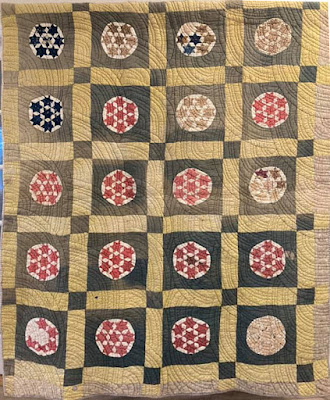Quilt attributed in the family to Mary Angeline Neely Fogle,
about 1890
Collection of Polly Mello
Mary Angeline Neely Fogle (1868–1950)
The quilt is pieced of plains and prints with a yellow dotted sashing.
Quilting is typical Southern fans design.
Detail "Rebel Outrages in Texas”
Frank Leslie's Illustrated Weekly February 20, 1864
Mary Angeline, born after the Civil War, undoubtedly heard the terrible story of how her mother (Elizabeth Ann Burch Neely 1842-1896) and grandmother (Mary McConnel Burch) brought Barnibus Burch's body home from Gainesville and buried him on their farm southeast of town. The women who dug the grave as best they could obviously had no men to help them.
James Martin Neely Jr. (1835-1927)
Elizabeth's husband James appears to have been in Little Rock, Arkansas at the time where he enlisted in Charles Leroy Morgan's Confederate Texas Cavalry Battalion on October 10, 1862. He'd been in Charles DeMorse's 29th Texas Cavalry Regiment earlier in the year.
Barnabus Burch's grave in the grown-over fence line
from Find-A-Grave.
Had the young Confederate private been at home might he have saved his doddering father-in-law from the noose? Barnabus seems harmless, a 70-year-old man too crippled to ride a horse who testified at his vigilante trial with stories of a dream of peace, good whiskey and a Bible quote. They hung him as a Union threat to the community, as they did 43 other mob victims in October.
The Leslie's illustration of "Rebel Barbarities"
took liberties with the facts. Executions took place a few
at a time over a period of days.
When her father was killed Elizabeth was the 20-year-old mother of infant James Austin Neely named for his father. She might also have been caring for stepchildren 3-year-old Laura and Charles Martin Neely, 5-year-old son of her husband's first wife, the boys the only males in the Burch/Neely family living on the farm near Burns City. Elizabeth's mother, Mary McConnell Burch, Barnabus's second wife, had one son David A. Burch and seven daughters.

Gainesville is up by the border of what is now Oklahoma,
then Indian Territory.
The blogger at GainesvilleTX1862 has done much writing about the Great Hanging:
"Most of the Burch family...traveled back to Missouri sometime after their father died... Elizabeth Ann Burch Neely left Texas and took her little family to Missouri to live with her older half-brothers. [Polly's been told she drove an oxcart with her children in it.] Elizabeth's younger sisters most likely traveled with her... it seems as if the younger children of Barnabus Burch were scattered, living with whoever would take them in. It is not known what happened to their mother, Mary.
Thomas Hart Benton painted the second Dallas County Courthouse in
1965 remembering the townsfolk who gathered to gossip
in the yard.
Elizabeth is buried in Cooke County,
Texas.
Awful as the Texas memories were the Neelys returned to Texas, to Burns City where Mary Angeline married Cornelius Avant Fogle in 1896, perhaps the occasion for which the quilt was made.
Wedding picture of Cornelius & Mary Neely Fogle?
The 1900 Cooke County, Texas census finds Mary, 2-year-old Josie and husband Cornelius who is listed as a blacksmith.
Katie Hawkins married twice according
to Find-A-Grave
Cornelius had been married before; apparently he and first wife Katie Hawkins divorced in the mid- 1890s
The 1910 census lists the Fogles in Avoca, Pottawatomie County, Oklahoma with their four children. Clide was born in 1907 in the new state indicating they moved there sometime about 1905. And that's where they stayed. Avoca is southeast of Shawnee.
Shawnee, the county seat, in 1907
Polly writes: "There are two monuments in Gainesville at the site of the Hanging Tree: One of pink granite was placed there in the 1960s and supported the people that hung the 'northern sympathizers'."
Polly's dad Henry Fogle, great-grandson of Elizabeth & James
"I remember my father saying in the 1960s that that it was not safe to bring up the subject of the hanging even then. In 2014, fifty years later, another Monument was placed on the site remembering those that were hung placed by descendants of the hanged."
As we have recently seen---every insurrection has a demagogue in charge and in Gainesville it was James Bourland. Head of a Secessionist military group, he knew how to appeal to the paranoid, the gullible and the conspiracy-obsessed when he convinced locals that men like Barnabus were plotting to bring in Kansas Union Jayhawkers from 500 miles away.
James G. Bourland 1801-1879
After the war there was talk of prosecuting Bourland for murder but it never happened. In his late 70s he slipped into dementia and as he was dying in 1879 newspaper editors had a bit to say about his crimes and his reputation.
Austin American, September 1879
He still had his supporters.
Bourland's grave in Dexter, Cooke County, from Find-A-Grave
Richard B. McCaslin is the authority on The Great Hanging. Read a preview of his chapter in The Fate of Texas here:



























Well civil war is not a good option humans have to suffer from it. To stand for you rights you have take actions on your hands.
ReplyDelete